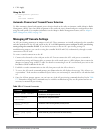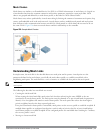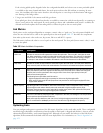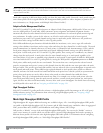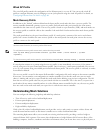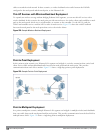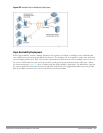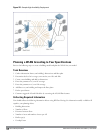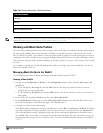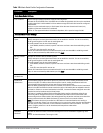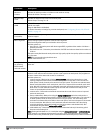
Wired AP Profile
The wired AP profile controls the configuration of the Ethernet port(s) on your AP. You can use the wired AP
profile to configure Ethernet ports for bridging or secure jack operation using the wired AP profile. For details, see
"Configuring Ethernet Ports for Mesh" on page 464
Mesh Recovery Profile
In addition to the “default” and user-defined mesh cluster profiles, mesh nodes also have a recovery profile. The
master controller dynamically generates a recovery profile, and each mesh node provisioned by the same master
controller has the same recovery profile. The recovery profile is based on a pre-shared key (PSK), and mesh nodes use
the recovery profile to establish a link to the controller if the mesh link is broken and no other mesh cluster profiles
are available.
The mesh portal advertises the provisioned cluster profile. If a mesh point is unaware of the active mesh cluster
profile, but is aware of and has the same recovery profile as the mesh portal, the mesh point can use the recovery
profile to connect to the mesh portal.
NOTE: The mesh point must have the same recovery profile as the parent to which it connects. If you provision the mesh points with
the same master controller, the recovery profiles should match.
To verify that the recovery profile names match, use the following command:
show ap mesh debug provisioned-clusters {ap-name <name> | bssid <bssid> | ip-addr
<ipaddr>}.
To view the recovery profile on the controller, use the following command: show running-config | include recovery.
If a mesh point connects to a parent using the recovery profile, it may immediately exit recovery if the parent is
actively using one of its provisioned mesh cluster profiles. Once in recovery, a mesh point periodically exits recovery
to see if it can connect using an available provisioned mesh cluster profile. The recovery profile is read-only; it cannot
be modified or deleted.
The recovery profile is stored in the master Dell controllers’ configuration file and is unique to that master controller.
If necessary, you can transfer your configuration to another controller. If you do this, make sure your new mesh
cluster is running and you have re-provisioned the mesh nodes before deleting your previous configuration. The APs
learn the new recovery profile after they are provisioned with the new controller. This is also true if you provision a
mesh node with one master controller and use it with a different master controller. In this case, the recovery profile
does not work on the mesh node until you re-provision it with the new master controller.
Understanding Mesh Solutions
You can configure the following single-hop and multi-hop solutions:
l Thin AP services with wireless backhaul deployment
l Point-to-point deployment
l Point-to-multipoint deployment
l High-availability deployment
With a thin AP wireless backhaul deployment, mesh provides services and security to remote wireless clients and
sends all control and user traffic to the master controller over a wireless backhaul mesh link.
The remaining deployments allow you to extend your existing wired network by providing a wireless bridge to
connect Ethernet LAN segments. You can use these deployments to bridge Ethernet LANs between floors, office
buildings, campuses, factories, warehouses and other environments where you do not have access to physical ports or
DellPowerConnectW-SeriesArubaOS6.2 | User Guide SecureEnterpriseMesh | 445



